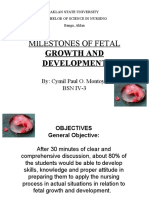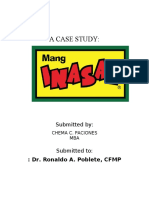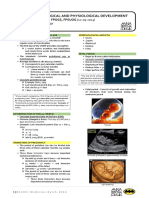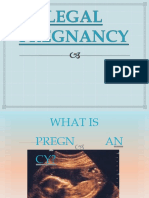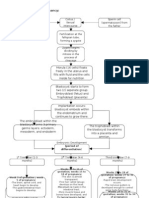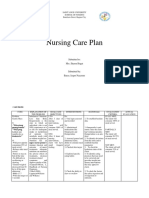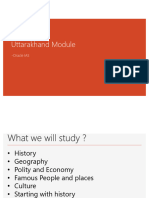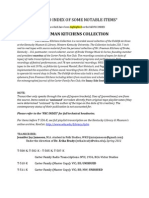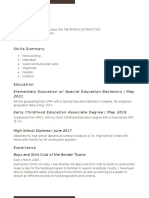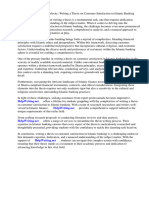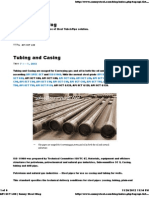0 ratings0% found this document useful (0 votes)
25 views"Fetal Development Milestone": Weeks Organ To Be Developed Clinical Implication
"Fetal Development Milestone": Weeks Organ To Be Developed Clinical Implication
Uploaded by
SoniaMarieBalanayThe document describes fetal development milestones at the end of 4th, 8th, 12th, 16th, 20th, 28th, 32nd, 36th, and 40th gestational weeks. Key developments include organogenesis being complete by the 8th week, discernible facial features and developing arms and legs. By the 12th week, nail beds are forming and bone ossification begins. The fetus is actively swallowing amniotic fluid by the 16th week. By the 20th week, spontaneous fetal movements can be sensed, meconium is present in the intestine, and sleeping/activity patterns are distinguishable. Lung alveoli begin to mature by the 28th week. By the 40th
Copyright:
© All Rights Reserved
Available Formats
Download as DOCX, PDF, TXT or read online from Scribd
"Fetal Development Milestone": Weeks Organ To Be Developed Clinical Implication
"Fetal Development Milestone": Weeks Organ To Be Developed Clinical Implication
Uploaded by
SoniaMarieBalanay0 ratings0% found this document useful (0 votes)
25 views3 pagesThe document describes fetal development milestones at the end of 4th, 8th, 12th, 16th, 20th, 28th, 32nd, 36th, and 40th gestational weeks. Key developments include organogenesis being complete by the 8th week, discernible facial features and developing arms and legs. By the 12th week, nail beds are forming and bone ossification begins. The fetus is actively swallowing amniotic fluid by the 16th week. By the 20th week, spontaneous fetal movements can be sensed, meconium is present in the intestine, and sleeping/activity patterns are distinguishable. Lung alveoli begin to mature by the 28th week. By the 40th
Original Description:
MILESTONE
Original Title
Balanay Palod Geron
Copyright
© © All Rights Reserved
Available Formats
DOCX, PDF, TXT or read online from Scribd
Share this document
Did you find this document useful?
Is this content inappropriate?
The document describes fetal development milestones at the end of 4th, 8th, 12th, 16th, 20th, 28th, 32nd, 36th, and 40th gestational weeks. Key developments include organogenesis being complete by the 8th week, discernible facial features and developing arms and legs. By the 12th week, nail beds are forming and bone ossification begins. The fetus is actively swallowing amniotic fluid by the 16th week. By the 20th week, spontaneous fetal movements can be sensed, meconium is present in the intestine, and sleeping/activity patterns are distinguishable. Lung alveoli begin to mature by the 28th week. By the 40th
Copyright:
© All Rights Reserved
Available Formats
Download as DOCX, PDF, TXT or read online from Scribd
Download as docx, pdf, or txt
0 ratings0% found this document useful (0 votes)
25 views3 pages"Fetal Development Milestone": Weeks Organ To Be Developed Clinical Implication
"Fetal Development Milestone": Weeks Organ To Be Developed Clinical Implication
Uploaded by
SoniaMarieBalanayThe document describes fetal development milestones at the end of 4th, 8th, 12th, 16th, 20th, 28th, 32nd, 36th, and 40th gestational weeks. Key developments include organogenesis being complete by the 8th week, discernible facial features and developing arms and legs. By the 12th week, nail beds are forming and bone ossification begins. The fetus is actively swallowing amniotic fluid by the 16th week. By the 20th week, spontaneous fetal movements can be sensed, meconium is present in the intestine, and sleeping/activity patterns are distinguishable. Lung alveoli begin to mature by the 28th week. By the 40th
Copyright:
© All Rights Reserved
Available Formats
Download as DOCX, PDF, TXT or read online from Scribd
Download as docx, pdf, or txt
You are on page 1of 3
Balanay, Sonia Marie L.
BSN IV – B
“Fetal Development Milestone”
Weeks Organ to be Developed Clinical Implication
End of 4th Length: 0.75 to 1 cm; Weight: 400 mg. May have positive results in
Gestational Week Spinal cord is formed and fused at midpoint. a hormone pregnancy test
Lateral wings that will form the body are folded Basal body temperature may
forward to fuse at the midline. be higher than usual
Head folds forward, becoming prominent, Mild uterine cramping
representing about one third of the entire Morning sickness
structure.
The back is bent so the head almost touches the
tip of the tall.
The rudimentary heart appears as a prominent
bulge on the anterior surface.
Arms and legs are budlike structures.
Rudimentary eyes, ears, and nose are
discernible.
End of 8th Length: 2.5 cm (1 in.); Weight: 20 g. Brain waves can already be
Gestational Week Organogenesis is complete. detected by the ECG
The heart, with a septum and valves, is beating The abdomen bulges
rhythmically. forward because the fetal
Facial features are definitely discernible. intestine is growing so
Arms and legs have developed. rapidly.
External genitalia are forming, but sex is not yet Sonogram shows a
distinguishable by simple observation. gestational sac, diagnostic
The primitive tail is regressing. of pregnancy.
Eyes, inner ears develop as projections of the
original neural tube.
End of 12th Length: 7 to 8 cm; Weight: 45 g. The heartbeat is audible
Gestational Week Nail beds are forming on fingers and toes. through Doppler
(First Trimester) Some reflexes, such as the Babinski reflex, are technology.
present. Spontaneous movements are
Bone ossification centers begin to form. possible, although they are
Tooth buds are present. usually too faint to be felt
Sex is distinguishable by outward appearance. by the mother.
Urine secretion begins but may not yet be
evident in amniotic fluid.
End of 16th Length: 10 to 17 cm; Weight: 55 to 120 g. Fetal heart sounds are
Gestational Week Lanugo is well formed. audible by an ordinary
Liver and pancreas are functioning. stethoscope.
Fetus actively swallows amniotic fluid, Sex can be determined by
demonstrating an intact but uncoordinated ultrasound.
swallowing reflex; urine is present in amniotic
fluid.
Urine is present in amniotic fluid.
End of 20th Length: 25 cm; Weight: 223 g. Spontaneous fetal
Gestational Week Antibody production is possible. movements can be sensed
The hair forms on the head, extending to by the mother.
include eyebrows.
Meconium is present in the upper intestine. Fetal heartbeat strong to be
Brown fat forms. audible.
Vernix caseosa produced by sebaceous gland.
Passive antibody transfer from mother to fetus
begins.
Definite sleeping and activity patterns are
distinguishable.
End of 28th Length: 35 to 38 cm; Weight: 1,200 g. The blood vessels of the
Gestational Week Eyes open. retina are formed but thin
Lung alveoli begin to mature. and extremely susceptible to
Testes to begin to descend. damage from high oxygen
Surfactant found in amniotic fluid. concentrations (an
important consideration
when caring for preterm
infants who need oxygen).
End of 32nd Length: 38 to 43 cm; Weight: 1,600 g Active Moro reflex is
Gestational Week Subcutaneous fat begins to be deposited (the present.
former stringy, “little old man” appearance is Fetus responds by
lost). movement to sounds outside
Iron stores, which provide iron for the time the mother’s body.
during which the neonate will ingest only milk (Former stringy, “little old
after birth, are beginning to be developed. man” appearance is lost).
Fingernails grow to reach the end of fingertips. Birth position may be
assumed.
End of 36th Length: 42 to 48 cm; Weight: 1,800 to 2,700 g Most babies turn into a
Gestational Week (5 to 6 lbs.) vertex (head down)
Body stores of glycogen, iron, carbohydrate, presentation during this
and calcium are deposited. month.
Additional amounts of subcutaneous fat are Sole of the foot has only
deposited. one or two crisscross
Amount of lanugo begins to diminish. creases, compared with the
full crisscross pattern that
will be evident at term.
End of 40th Length: 48 to 52 cm; Weight: 3,000g Fetus kicks actively, hard
Gestational Week (7 to 7.5 lbs.) enough to cause the mother
(Third Trimester) Fetal hemoglobin begins its conversion to adult considerable discomfort.
hemoglobin. Creases on the soles of the
Vernix caseosa is fully formed. feet cover at least two thirds
Fingernails extend over the fingertips. of the surface.
Reference:
Johnson, Joyce Young., et al. Study Guide to Accompany Maternal & Child Health Nursing: Care of the
Childbearing & Childrearing Family. Wolters Kluwer/Lippincott Williams & Wilkins, 2008.
You might also like
- CH01Document30 pagesCH01Raneem AbdullahNo ratings yet
- Oath of The Eldritch HuntDocument1 pageOath of The Eldritch HuntLucas Lemos100% (1)
- Night On The Galactic Railroad - Kenji MiyazawaDocument200 pagesNight On The Galactic Railroad - Kenji MiyazawaDavid SmithNo ratings yet
- Milestones of Fetal Growth and Development Power PointDocument24 pagesMilestones of Fetal Growth and Development Power PointCymilo100% (1)
- Fetal Development by Lunar MonthsDocument10 pagesFetal Development by Lunar MonthsKyla AbrencilloNo ratings yet
- FNCP FinaaaalDocument5 pagesFNCP FinaaaalSoniaMarieBalanay0% (1)
- A Case Study::: Dr. Ronaldo A. Poblete, CFMPDocument8 pagesA Case Study::: Dr. Ronaldo A. Poblete, CFMPMeach CallejoNo ratings yet
- End of Fourth Gestational WeekDocument3 pagesEnd of Fourth Gestational WeekCamille De Jesus100% (1)
- 3 - Nursing Role in Reproductive and Sexual HealthDocument10 pages3 - Nursing Role in Reproductive and Sexual HealthShanealle Athaliah Magsalay CuaNo ratings yet
- Fetal DevelopmentDocument7 pagesFetal DevelopmentSamson BongsiwNo ratings yet
- Ib1 Sas 9Document7 pagesIb1 Sas 9RonaldGen AnggapNo ratings yet
- Growing FetusDocument4 pagesGrowing FetusMaria ThereseNo ratings yet
- Fetal Growth and DevelopmentDocument3 pagesFetal Growth and DevelopmentAngel Shaina VillanuevaNo ratings yet
- Fetal DevDocument2 pagesFetal Devtyaneo2010No ratings yet
- Answer The Following:: Assessment On Fetal Growth and DevelopmentDocument10 pagesAnswer The Following:: Assessment On Fetal Growth and DevelopmentNur AleahNo ratings yet
- Ob1 Sas 10Document8 pagesOb1 Sas 10tmsollano04No ratings yet
- 2nd TrasesnsDocument8 pages2nd TrasesnssenecabheNo ratings yet
- Fetal Developmental MilestonesDocument28 pagesFetal Developmental MilestonesShahad HakimuddinNo ratings yet
- 1-Pre-Natal PeriodDocument61 pages1-Pre-Natal PeriodLady Mairyl N. BrigondoNo ratings yet
- Milestone of Fetal Growth and DevelopmentDocument21 pagesMilestone of Fetal Growth and DevelopmentPrecious Abueg RNNo ratings yet
- Cleavage Cleavage: 6th Month: 14 In. Long 2 Lbs. Baby's Rain Develops Rapidly, Eyelids Are Formed and Able To HiccupDocument1 pageCleavage Cleavage: 6th Month: 14 In. Long 2 Lbs. Baby's Rain Develops Rapidly, Eyelids Are Formed and Able To HiccupJulia ObcenaNo ratings yet
- FETAL DEVELOPMENT - CopyDocument36 pagesFETAL DEVELOPMENT - Copyalmayasa2002No ratings yet
- Milestones of Fetal Growth AND DevelopmentDocument31 pagesMilestones of Fetal Growth AND DevelopmentBryan Lloyd Ballestar RayatNo ratings yet
- MCN ReviewerDocument5 pagesMCN ReviewerShar EnriquezNo ratings yet
- PHYT 6222 Prenatal Development/Maternal Changes: Lecture ObjectivesDocument4 pagesPHYT 6222 Prenatal Development/Maternal Changes: Lecture ObjectivesSheril MarekNo ratings yet
- MCN - Milestones For Fetal Growth and DevelopmentDocument5 pagesMCN - Milestones For Fetal Growth and DevelopmentBenjo Dela CruzNo ratings yet
- Fetal Milsetone and DevelopementDocument4 pagesFetal Milsetone and DevelopementJemma NocalanNo ratings yet
- Zygote: Eight-Cell Stage Blastula GastrulaDocument1 pageZygote: Eight-Cell Stage Blastula GastrulaJulia ObcenaNo ratings yet
- Maternal-Reviewer MDocument2 pagesMaternal-Reviewer MAia RecaidoNo ratings yet
- Milestone of Fetal Development First Trimester Endof4 Gestational WeekDocument4 pagesMilestone of Fetal Development First Trimester Endof4 Gestational WeekJustJ ThingsNo ratings yet
- Fetal Morphological and Physiological Development PDFDocument10 pagesFetal Morphological and Physiological Development PDFKim RamosNo ratings yet
- Fetal and Growth Development IDocument12 pagesFetal and Growth Development Ijuliannecalvo221No ratings yet
- D.Fetal CirculationDocument5 pagesD.Fetal CirculationJulio NazarethNo ratings yet
- Ateneo de Zamboanga University: College of Nursing Level 2 - Module 1 - Activity Sheet FormsDocument11 pagesAteneo de Zamboanga University: College of Nursing Level 2 - Module 1 - Activity Sheet FormsNur SetsuNo ratings yet
- The Growing FetusDocument16 pagesThe Growing FetusLady Jane CaguladaNo ratings yet
- Pregnancyslideshow 120804044533 Phpapp01Document29 pagesPregnancyslideshow 120804044533 Phpapp01Frenella SandovalNo ratings yet
- Assessing Newborns and Infants RevieweDocument11 pagesAssessing Newborns and Infants RevieweLaurisse April Necesito100% (1)
- Chapter 4 PresentationDocument6 pagesChapter 4 PresentationLhekha RaviendranNo ratings yet
- The Fetal Period: by DR - Abdallah GreeballahDocument55 pagesThe Fetal Period: by DR - Abdallah GreeballahrawanNo ratings yet
- Physiology of PregnancyDocument2 pagesPhysiology of PregnancyjamiegemNo ratings yet
- 33 Home Science Unit 02Document19 pages33 Home Science Unit 02Jaynal HussainNo ratings yet
- Stages of PregnancyDocument14 pagesStages of PregnancyRovilyn DizonNo ratings yet
- Labor and DeliveryDocument7 pagesLabor and DeliveryMikaella CondeNo ratings yet
- RevkeDocument11 pagesRevkeLowellyn Grezen VillaflorNo ratings yet
- Care of The Mother and The Fetus During The Prenatal Period (Part 2)Document20 pagesCare of The Mother and The Fetus During The Prenatal Period (Part 2)Austine James Sabenicio PantiloNo ratings yet
- Prenatal DevelopmentDocument37 pagesPrenatal DevelopmentAbegail JanorasNo ratings yet
- HUMANDocument28 pagesHUMANcandiNo ratings yet
- Grade 10 Fetal DevelopmentDocument30 pagesGrade 10 Fetal DevelopmentsultanirishshaineNo ratings yet
- LABOR and BIRTHDocument13 pagesLABOR and BIRTHglabisigNo ratings yet
- Age Fetal Development Approximate Length Approximate Weight: Sex DistinguishableDocument2 pagesAge Fetal Development Approximate Length Approximate Weight: Sex DistinguishableChigas ManilaNo ratings yet
- Monthwise Fetal DevelopmentDocument1 pageMonthwise Fetal DevelopmentNikkNo ratings yet
- Educ 11 Unit 2 ActivityDocument15 pagesEduc 11 Unit 2 ActivityQueen DaguroNo ratings yet
- Perkembangan FetusDocument43 pagesPerkembangan FetusAditya PrambudhiNo ratings yet
- Fetal DevelopmentchartDocument1 pageFetal DevelopmentchartVector FefNo ratings yet
- WK 5Document62 pagesWK 5gpbantaNo ratings yet
- Breechpresentation Copy 141124075623 Conversion Gate02 PDFDocument38 pagesBreechpresentation Copy 141124075623 Conversion Gate02 PDFKathirNo ratings yet
- Stages of PregnancyDocument16 pagesStages of PregnancyLenie Mae AbadianoNo ratings yet
- Stages of Fetal DevelopmentDocument6 pagesStages of Fetal DevelopmentMark ElbenNo ratings yet
- Female Pelvis and MeasurementsDocument21 pagesFemale Pelvis and MeasurementsBia Khan100% (1)
- Labor and Birth Process and NURSING MANAGEMENT (Chapter 13 and 14) False Labor Factors That Affect LaborDocument7 pagesLabor and Birth Process and NURSING MANAGEMENT (Chapter 13 and 14) False Labor Factors That Affect LaborSHARLAIN GAIL V. MELECIONo ratings yet
- InfanticicdeDocument14 pagesInfanticicdeblessysamarpangellaNo ratings yet
- Rusco Reporting NotesDocument3 pagesRusco Reporting Notesterence.duterteNo ratings yet
- Anatomical Difference in OvariesDocument9 pagesAnatomical Difference in OvariesAshok Balwada100% (1)
- ReflectionDocument2 pagesReflectionSoniaMarieBalanayNo ratings yet
- Psychopathology Mayana FinallllDocument2 pagesPsychopathology Mayana FinallllSoniaMarieBalanayNo ratings yet
- Ward Analysis BudgetingDocument5 pagesWard Analysis BudgetingSoniaMarieBalanayNo ratings yet
- Decreased Cardiac Output Related To Decreased Myocardial Contractility Secondary To CardiomyopathyDocument2 pagesDecreased Cardiac Output Related To Decreased Myocardial Contractility Secondary To CardiomyopathySoniaMarieBalanayNo ratings yet
- Journal About MommaDocument4 pagesJournal About MommaSoniaMarieBalanayNo ratings yet
- OPD JOURNAL REACTION Sutures Vs StaplesDocument4 pagesOPD JOURNAL REACTION Sutures Vs StaplesSoniaMarieBalanayNo ratings yet
- Inflammatory Response: PathophysiologyDocument2 pagesInflammatory Response: PathophysiologySoniaMarieBalanayNo ratings yet
- FNCP FinaaaalDocument10 pagesFNCP FinaaaalSoniaMarieBalanayNo ratings yet
- Copy NG ReflectionDocument3 pagesCopy NG ReflectionSoniaMarieBalanayNo ratings yet
- FNCP ProperDocument3 pagesFNCP ProperSoniaMarieBalanayNo ratings yet
- Drug StudyDocument3 pagesDrug StudySoniaMarieBalanayNo ratings yet
- Valium DSDocument2 pagesValium DSSoniaMarieBalanayNo ratings yet
- Before: Source: Source: Source: Source: Source: Source: Source: Karch, Amy: 2009 Lippincott's Nursing Drug Guide, P. 407Document2 pagesBefore: Source: Source: Source: Source: Source: Source: Source: Karch, Amy: 2009 Lippincott's Nursing Drug Guide, P. 407SoniaMarieBalanayNo ratings yet
- Balanay Palod GeronDocument6 pagesBalanay Palod GeronSoniaMarieBalanayNo ratings yet
- "Proper Wound Care": Also Eat Food Rich in Protein To Increase Wound HealingDocument2 pages"Proper Wound Care": Also Eat Food Rich in Protein To Increase Wound HealingSoniaMarieBalanayNo ratings yet
- Subjective: Sto: DX: Fully Met: TheDocument2 pagesSubjective: Sto: DX: Fully Met: TheSoniaMarieBalanayNo ratings yet
- FNCP AhettDocument4 pagesFNCP AhettSoniaMarieBalanayNo ratings yet
- NCP Impaired SkinDocument4 pagesNCP Impaired SkinSoniaMarieBalanayNo ratings yet
- Precious Heritage School of Zambales Magsaysay, Castillejos, Zambales Grade - 10Document1 pagePrecious Heritage School of Zambales Magsaysay, Castillejos, Zambales Grade - 10SoniaMarieBalanayNo ratings yet
- Ncp-Proper Sonia FinalDocument4 pagesNcp-Proper Sonia FinalSoniaMarieBalanayNo ratings yet
- Nursing Care Plan: Saint Louis University School of Nursing Bonifacio Street, Baguio CityDocument5 pagesNursing Care Plan: Saint Louis University School of Nursing Bonifacio Street, Baguio CitySoniaMarieBalanayNo ratings yet
- Pain Assessment and Management in Cancer Patients: Saint Louis University School of NursingDocument3 pagesPain Assessment and Management in Cancer Patients: Saint Louis University School of NursingSoniaMarieBalanayNo ratings yet
- Nursing Care Plan: Saint Louis University School of Nursing Bonifacio Street, Baguio CityDocument3 pagesNursing Care Plan: Saint Louis University School of Nursing Bonifacio Street, Baguio CitySoniaMarieBalanayNo ratings yet
- Pathophysiology of AtherosclerosisDocument1 pagePathophysiology of AtherosclerosisSoniaMarieBalanayNo ratings yet
- NCP For DengueDocument6 pagesNCP For DengueSoniaMarieBalanayNo ratings yet
- PCMZ DLC: Our Legacy Will Continue! By: Myra Esposo - Clarin (Parent)Document10 pagesPCMZ DLC: Our Legacy Will Continue! By: Myra Esposo - Clarin (Parent)SoniaMarieBalanayNo ratings yet
- Best Practice & Research Clinical Endocrinology & MetabolismDocument10 pagesBest Practice & Research Clinical Endocrinology & MetabolismSilviaNathaliaNo ratings yet
- Homework #1: BAUTISTA, Maurice FDocument4 pagesHomework #1: BAUTISTA, Maurice FMau BautistaNo ratings yet
- BUSI2800 Assignment #1Document3 pagesBUSI2800 Assignment #1Átylla BritoNo ratings yet
- Final Exam B - Spring 2021Document11 pagesFinal Exam B - Spring 2021eswarsai saiNo ratings yet
- So and Such: The Ultimate PracticeDocument2 pagesSo and Such: The Ultimate PracticereherediamNo ratings yet
- Imd213 Individual Assignment (Cataloguing Process)Document23 pagesImd213 Individual Assignment (Cataloguing Process)Iman TasneemNo ratings yet
- J 1545-5300 1962 00015 XDocument7 pagesJ 1545-5300 1962 00015 XFausto Adrián Rodríguez LópezNo ratings yet
- Guamaua vs. EspinoDocument3 pagesGuamaua vs. EspinoCin100% (1)
- History 1Document14 pagesHistory 1Yash JoshiNo ratings yet
- Candidate Interview Evaluation PDFDocument2 pagesCandidate Interview Evaluation PDFAhmed Abo ElkassemNo ratings yet
- DETAILED INDEX of The Freeman Kitchens Collection, WKUDocument12 pagesDETAILED INDEX of The Freeman Kitchens Collection, WKUmissjamesonNo ratings yet
- INFOSYS GRAND TEST-1.protectedDocument9 pagesINFOSYS GRAND TEST-1.protectedsaieswar4uNo ratings yet
- Megan Wells: Skills SummaryDocument3 pagesMegan Wells: Skills Summaryapi-500180757No ratings yet
- Thesis On Customer Satisfaction in Islamic BankingDocument7 pagesThesis On Customer Satisfaction in Islamic Bankingangieflorespeoria100% (2)
- Management of Forgen Body InhalationDocument31 pagesManagement of Forgen Body Inhalationmonir61No ratings yet
- Autobiography Project - DedicationDocument14 pagesAutobiography Project - DedicationCleonice Aparecida MendesNo ratings yet
- API 5CT Casing MaterialDocument6 pagesAPI 5CT Casing Materialkaveh-bahiraee100% (2)
- Comp231 Logic 231219Document78 pagesComp231 Logic 231219omarrhany01No ratings yet
- Notes On Rape of The LockDocument5 pagesNotes On Rape of The LockKingshuk MondalNo ratings yet
- Rule of The ThirdDocument2 pagesRule of The ThirdUranusNo ratings yet
- Unit 3Document13 pagesUnit 3Shadan Yaseen FarooquiNo ratings yet
- Module 3 Nominal and Effective IR - RevDocument20 pagesModule 3 Nominal and Effective IR - RevTerra PradanaNo ratings yet
- TOS PRB CRM CRIMINOLOGY ConsolidatedDocument25 pagesTOS PRB CRM CRIMINOLOGY ConsolidatedLuise Marhie VerboNo ratings yet
- Under Imperialism Black Lives Don T Matter Ho Chi Minh The Black Race and Black LiberationDocument9 pagesUnder Imperialism Black Lives Don T Matter Ho Chi Minh The Black Race and Black LiberationRobot MateNo ratings yet
- 49 Surah Hujurat The Inner Apartments LinguisticMiracleDocument34 pages49 Surah Hujurat The Inner Apartments LinguisticMiraclemostrom100% (3)
- Adversity Quotient: Paul G. Stoltz, PHDDocument14 pagesAdversity Quotient: Paul G. Stoltz, PHDjaja c.No ratings yet



